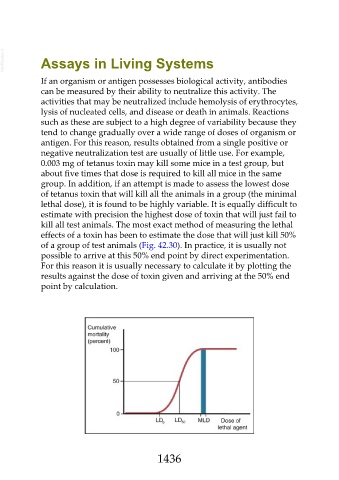Page 1436 - Veterinary Immunology, 10th Edition
P. 1436
VetBooks.ir Assays in Living Systems
If an organism or antigen possesses biological activity, antibodies
can be measured by their ability to neutralize this activity. The
activities that may be neutralized include hemolysis of erythrocytes,
lysis of nucleated cells, and disease or death in animals. Reactions
such as these are subject to a high degree of variability because they
tend to change gradually over a wide range of doses of organism or
antigen. For this reason, results obtained from a single positive or
negative neutralization test are usually of little use. For example,
0.003 mg of tetanus toxin may kill some mice in a test group, but
about five times that dose is required to kill all mice in the same
group. In addition, if an attempt is made to assess the lowest dose
of tetanus toxin that will kill all the animals in a group (the minimal
lethal dose), it is found to be highly variable. It is equally difficult to
estimate with precision the highest dose of toxin that will just fail to
kill all test animals. The most exact method of measuring the lethal
effects of a toxin has been to estimate the dose that will just kill 50%
of a group of test animals (Fig. 42.30). In practice, it is usually not
possible to arrive at this 50% end point by direct experimentation.
For this reason it is usually necessary to calculate it by plotting the
results against the dose of toxin given and arriving at the 50% end
point by calculation.
1436

